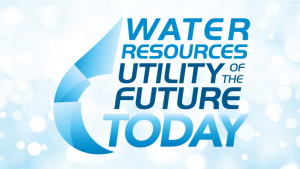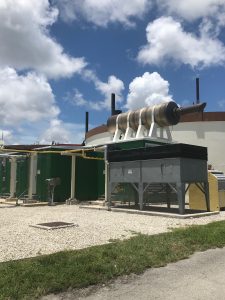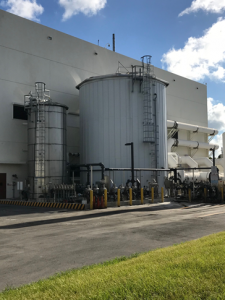
Click here for details on the Utility of the Future Today program, established in 2016 by the Water Environment Federation (Alexandria, Va.), the National Association of Clean Water Agencies (Washington, D.C.), the Water Research Foundation (Alexandria, Va.), WateReuse Association (Alexandria, Va.), and the U.S. Environmental Protection Agency.
Water resource recovery facility (WRRF) managers in Broward County, Fla., have been working actively for nearly a decade to reduce the utility’s carbon emissions and improve energy efficiency without compromising its high standard of wastewater treatment.
At WEFTEC 2019, the Water Environment Federation (WEF; Alexandria, Va.) and its partners recognized Broward County Water and Wastewater Services (WWS) as a Utility of the Future Today for its innovative efforts to ensure operational sustainability.
Cutting Costs and Carbon Emissions

In 2015, the Broward County Water and Wastewater Services (WWS) installed an energy generation and recovery system at its 360-ML/d (95-mgd) North Regional Wastewater Treatment Plant in Pompano Beach, Fla. The system, developed in partnership with ENGIE Services U.S. (Oakland, Calif.), enables WWS to use the facility’s existing anaerobic digesters to produce energy from fats, oils, and grease. Photo: Broward County (Fla.) Water and Wastewater Services.
In 2015, Broward County installed an energy generation and recovery system at its 360-ML/d (95-mgd) North Regional Wastewater Treatment Plant in Pompano Beach, Fla. The system, developed in partnership with ENGIE Services U.S. (Oakland, Calif.), enables WWS to use the facility’s existing anaerobic digesters to produce energy from fats, oils, and grease (FOG).
Rather than being processed via secondary aeration, most FOG entering the facility now flows directly from the septage receiving area into the anaerobic digesters via a new injection point, according to Broward County’s Utility of the Future Today submission. The cogeneration system produces higher-quality biogas compared to conventional aeration, which is then refined into energy that reduces the facility’s need to purchase electricity from the county while also providing heat for the facility’s mesophilic digesters. Furthermore, the addition drastically reduces processing costs for FOG compared to the secondary aeration process.
After the project’s completion, the county achieved energy-cost savings of approximately $1.5 million per year, and reduced carbon dioxide emissions by about 21,000 tons – the equivalent to taking approximately 4,000 cars off the road. All told, the project reduced the treatment facility’s carbon footprint by more than 50%, according to a 2016 profile of the project released by Hazen and Sawyer (Fairfax, Va.).
Beyond the Nuts and Bolts
Putting innovative process technologies to work can result in myriad local benefits. However, Utilities of the Future are marked not only by technical proficiency, but by a progressive organizational culture that strikes a balance between financial, environmental, and community needs.
In its submission documents, WWS cites its “no-frills” style of rate-setting that has enabled the utility to keep its rate structures among the lowest in the state for more than 50 years. Despite low burdens on customers, the utility has managed to fund a “healthy” capital improvement program which helps ensure WWS can renew aging infrastructure, upgrade systems with a focus on efficiency and reliability, develop a qualified staff, and play an active role in the community.

After the project’s completion, the county achieved energy-cost savings of approximately $1.5 million per year, and reduced carbon dioxide emissions by about 21,000 tons – the equivalent to taking approximately 4,000 cars off the road. Photo: Broward County (Fla.) Water and Wastewater Services.
The organization boasts a history of helping other utilities recover after natural disasters, aiding local charities through community fundraising events, and making appearances at local schools to engage young people in water conservation. WWS also offers apprenticeship positions to local residents in an attempt to ensure workforce resilience as many water professionals approach retirement age.
“The infrastructure, processes, and technology are nothing without the qualified and dedicated people to make them happen,” writes WWS Operations Director Mark Darmanin in WWS’ submission. “The Utility of the Future is only as good as the people you have today, and the vision they translate into reality.”
Check the WEF website for updates on the submission period for the 2020 Utility of the Future Today program, set to open March 16, 2020.
— Justin Jacques, WEF Highlights
WEF Highlights Celebrates Utilities of the Future TodayAt WEFTEC 2019, the Water Environment Federation Utility of the Future Today program recognized 43 water utilities from around the world as leaders in water-sector sustainability and resilience. WEF Highlights will explore the innovations occurring behind the fences of these award-winning facilities. Follow these stories with the UOTF tag. |








December 11, 2019
Achievements, Technologies